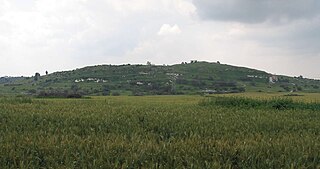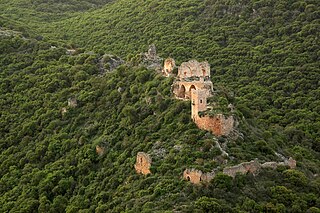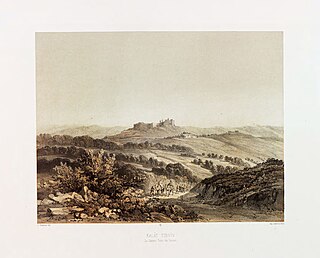 W
WAchziv is an ancient site on the Mediterranean coast of northern Israel, between the border with Lebanon and the city of Acre. It is located 13.5 kilometres (8.4 mi) north of Acre on the coast of the Mediterranean Sea, within the municipal area of Nahariya. Today it is an Israeli national park.
 W
WAl-Qastal was a Palestinian village located eight kilometers west of Jerusalem named for a Crusader castle located on the hilltop. Used as a military base by the Army of the Holy War, the village was captured by the Palmach in the lead up to the Arab-Israeli War and depopulated of its residents.
 W
WArwad, the classical Aradus, is a town in Syria on an eponymous island in the Mediterranean Sea. It is the administrative center of the Arwad Subdistrict (nahiyah), of which it is the only locality. It is the only inhabited island in Syria. It is located 3 km (1.9 mi) from Tartus, Syria's second-largest port.
 W
WBayt Jibrin, was a Palestinian village located 21 kilometers (13 mi) northwest of the city of Hebron. The village had a total land area of 56,185 dunams or 56.1 km2, of which 0.28 km2 were built-up while the rest remained farmland.
 W
WBeaufort or Belfort Castle, known locally as Qal'at al-Shaqif or Shaqif Arnun, is a Crusader fortress in Nabatieh Governorate, Southern Lebanon, about 1 kilometre (0.62 mi) to the south-south-east of the village of Arnoun. There was a fortification on the site before it was captured by Fulk, King of Jerusalem, in 1139 and construction of the Crusader castle probably began soon after. Saladin captured Beaufort in 1190, but 60 years later Crusaders re-took it. In 1268 Sultan Baibars finally captured the castle for the Islamic forces.
 W
WBelvoir Castle is a Crusader castle in northern Israel, on a hill 20 kilometres (12 mi) south of the Sea of Galilee. Gilbert of Assailly, Grand Master of the Knights Hospitaller, began construction of the castle in 1168. The restored castle is located in Belvoir National Park. It is the best-preserved Crusader castle in Israel.
 W
WBayt Jibrin, was a Palestinian village located 21 kilometers (13 mi) northwest of the city of Hebron. The village had a total land area of 56,185 dunams or 56.1 km2, of which 0.28 km2 were built-up while the rest remained farmland.
 W
WTell es-Safi was a Arab Palestinian village, located on the southern banks of Wadi 'Ajjur, 35 kilometers (22 mi) northwest of Hebron which had its Arab population expelled during the 1948 Arab-Israeli war on orders of Shimon Avidan, commander of the Givati Brigade.
 W
WCaesarea Maritima, formerly Strato's Tower, also known as Caesarea Palestinae, was an ancient city in the Sharon Plain on the coast of the Mediterranean, now in ruins and included in an Israeli national park.
 W
WYalo was a Palestinian Arab village located 13 kilometres southeast of Ramla. Identified by Edward Robinson as the ancient Canaanite and Israelite city of Aijalon, in the Middle Ages it was the site of a Crusader castle, Castrum Arnaldi. After the 1948 Arab-Israeli war, Jordan formally annexed Yalo along with the rest of the West Bank. Yalo's population increased dramatically owing to an influx of Palestinian refugees from neighbouring towns and villages depopulated during the 1948 war.
 W
WChamaa is a village and municipality in the Tyre District of Lebanon's South Governorate, about 25 kilometres southeast of Tyre and some 99 kilometres south of Beirut.
 W
WChâteau Pèlerin, also known as Atlit Castle and Pilgrim Castle, is a Crusader fortress located near Atlit on the northern coast of Israel, about 13 kilometres (8.1 mi) south of Haifa.
 W
WHaifa is the third-largest city in Israel—after Jerusalem and Tel Aviv—with a population of 285,316 in 2019. The city of Haifa forms part of the Haifa metropolitan area, the third-most populous metropolitan area in Israel. It is home to the Baháʼí Faith's Baháʼí World Centre, and is a UNESCO World Heritage Site and a destination for Baháʼí pilgrimage.
 W
WKerak Castle is a large Crusader castle located in al-Karak, Jordan. It is one of the largest crusader castles in the Levant. Construction of the castle began in the 1140s, under Pagan and Fulk, King of Jerusalem. The Crusaders called it Crac des Moabites or "Karak in Moab", as it is referred to in history books. It was also colloquially referred to as Krak of the Desert.
 W
WLe Destroit is a ruined medieval fortress, built by the Crusaders in the early 12th century CE, located near the town of Atlit, Israel.
 W
WMigdal Afek, also Migdal Tsedek, is a national park on the southeastern edge of Rosh HaAyin, Israel.
 W
WMontfort is a ruined Crusader castle in the Upper Galilee region in northern Israel, about 22 miles (35 km) northeast of the city of Haifa and 10 miles (16 km) south of the border with Lebanon.
 W
WMontreal, or Qal'at ash-Shawbak in Arabic, is a castle built by the Crusaders and expanded by the Mamluks, on the eastern side of the Arabah Valley, perched on the side of a rocky, conical mountain, looking out over fruit orchards below. The ruins are located next to the modern town of Shoubak in Jordan.
 W
WQaqun was a Palestinian Arab village located 6 kilometers (3.7 mi) northwest of the city of Tulkarm at the only entrance to Mount Nablus from the coastal Sharon plain.
 W
WRamla, also spelled Ramle, Ramlah, Remle and historically sometimes Rama, is a city in the Central District of Israel.
 W
WSafed is a city in the Northern District of Israel. Located at an elevation of 900 metres (2,953 ft), Safed is the highest city in the Galilee and in Israel.
 W
WSepphoris or Zippori in the past called Diocaesaraea and, during the Crusades, le Saforie, is a former village and an archaeological site located in the central Galilee region of Israel, 6 kilometers north-northwest of Nazareth. It lies 286 meters above sea level and overlooks the Beit Netofa Valley. The site holds a rich and diverse historical and architectural legacy that includes Hellenistic, ancient Jewish, Roman, Byzantine, Islamic, Crusader, Arab and Ottoman remains. In Mandatory Palestine it was a town known as Saffuriya, with a population of approximately 5,000 people, until its depopulation in 1948.
 W
WTartus is a city on the Mediterranean coast of Syria. It is the second largest port city in Syria, and the largest city in Tartus Governorate. The population is 115,769. In the summer it is a vacation spot for many Syrians. Many vacation compounds and resorts are located in the region. The port holds a small Russian naval facility.
 W
WTell es-Safi was a Arab Palestinian village, located on the southern banks of Wadi 'Ajjur, 35 kilometers (22 mi) northwest of Hebron which had its Arab population expelled during the 1948 Arab-Israeli war on orders of Shimon Avidan, commander of the Givati Brigade.
 W
WTiberias is an Israeli city on the western shore of the Sea of Galilee. Established around 20 CE, it was named in honour of the second emperor of the Roman Empire, Tiberius. In 2019 it had a population of 44,779.
 W
WToron, now Tibnin or Tebnine in southern Lebanon, was a major Crusader castle, built in the Lebanon mountains on the road from Tyre to Damascus. The castle was the centre of the Lordship of Toron, a seigneury within the Kingdom of Jerusalem, actually a rear-vassalage of the Principality of Galilee.
 W
WThe Tower of David, also known as the Citadel, is an ancient citadel located near the Jaffa Gate entrance to the Old City of Jerusalem.
 W
WTzova, also Palmach Tzova or Tzuba is a kibbutz in central Israel. Located in the Judean Hills, on the western outskirts of Jerusalem, it falls under the jurisdiction of Mateh Yehuda Regional Council. In 2019 it had a population of 625.
 W
WYalo was a Palestinian Arab village located 13 kilometres southeast of Ramla. Identified by Edward Robinson as the ancient Canaanite and Israelite city of Aijalon, in the Middle Ages it was the site of a Crusader castle, Castrum Arnaldi. After the 1948 Arab-Israeli war, Jordan formally annexed Yalo along with the rest of the West Bank. Yalo's population increased dramatically owing to an influx of Palestinian refugees from neighbouring towns and villages depopulated during the 1948 war.